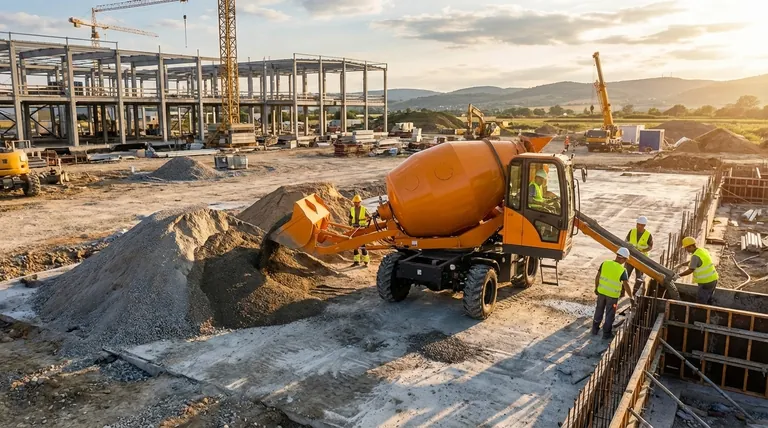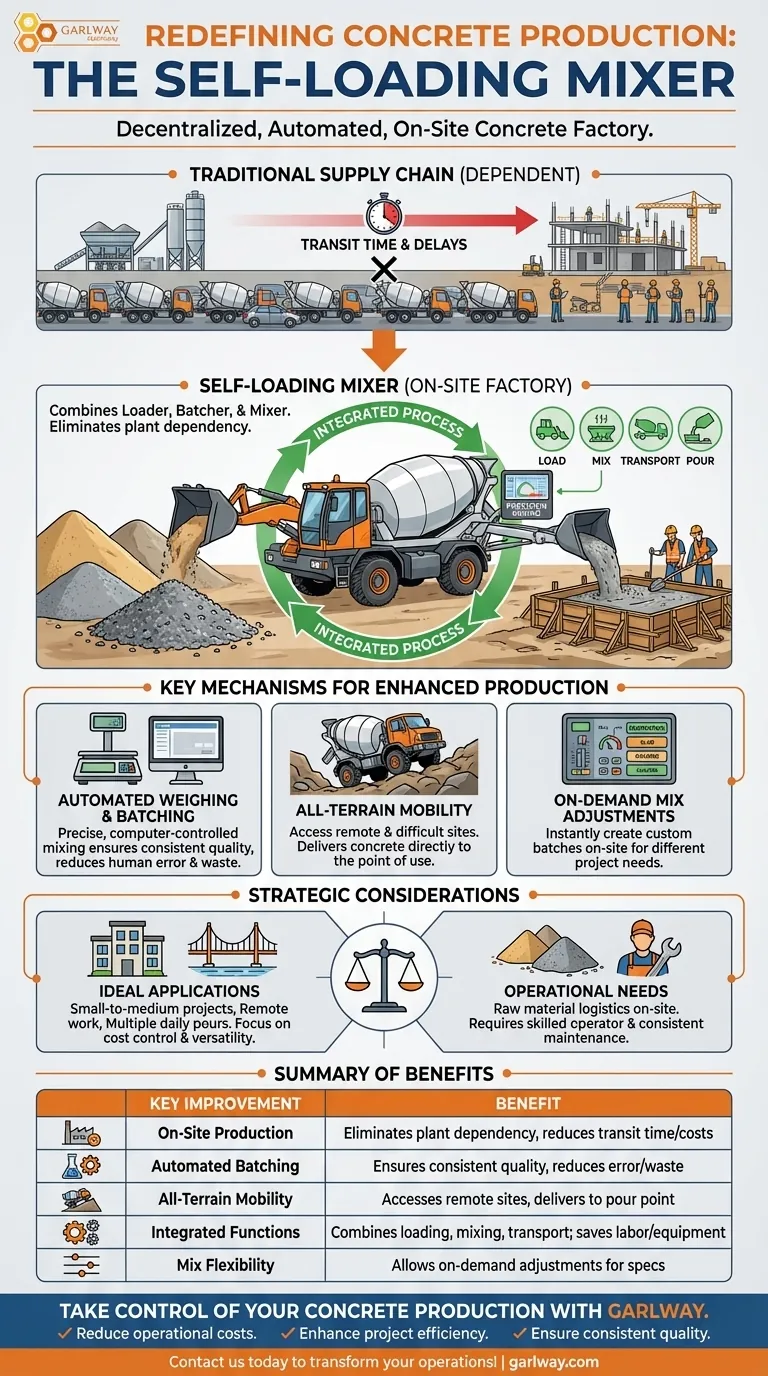Self-loading concrete mixers fundamentally redefine the logistics of concrete production. They achieve this by combining a wheel loader, a batching plant, and a transit mixer into a single, automated machine that operates directly on the construction site. This integrated approach enhances production by ensuring consistent quality, providing unmatched mobility, and dramatically reducing reliance on external plants and auxiliary equipment.
By decentralizing concrete production from a central plant to a single, mobile unit, self-loading mixers grant construction projects unprecedented control over timing, quality, and material usage, directly translating to reduced costs and faster project completion.

The Core Shift: From Supply Chain to On-Site Factory
A self-loading mixer isn't just a different type of truck; it's a different operational philosophy. It transforms concrete production from a logistical challenge involving multiple locations and machines into a streamlined, on-demand process controlled at the job site.
Eliminating Batching Plant Dependency
Traditionally, projects are beholden to the schedule and location of a concrete batching plant. Self-loading mixers eliminate this dependency.
By producing concrete exactly where it's needed, you remove transit time, potential traffic delays, and the fuel costs associated with multiple truck trips. This also ensures every batch is perfectly fresh, a critical factor for quality.
Integrating Multiple Machines into One
The typical concrete process requires a wheel loader to handle aggregates, a batching plant for mixing, and a transit mixer for transport.
A self-loading mixer performs all these functions. Its front-end shovel loads raw materials, its onboard system weighs and mixes them, and the machine itself transports the finished concrete to the pour site. This consolidation reduces the need for extra machinery and the labor required to operate it.
Key Mechanisms for Enhanced Production
The improvements offered by self-loading mixers stem from specific technological and design advantages that address common pain points in traditional concrete work.
Automated Weighing and Batching
Human error in measuring materials is a common source of inconsistent concrete quality. These mixers use precise, automated weighing systems and onboard computers.
An operator simply selects the pre-programmed mix design, and the machine ensures every batch is identical. This consistency enhances structural integrity, reduces costly mistakes, and minimizes material wastage.
All-Terrain Mobility and Access
Many construction sites are located in remote areas, congested urban spaces, or on rough terrain where standard transit mixers struggle to operate.
Self-loading mixers are typically designed with four-wheel drive, robust suspension, and excellent maneuverability. This allows them to access difficult sites and deliver concrete directly to the point of use, saving time and labor associated with wheelbarrows or pumps.
On-Demand Mix Adjustments
A single project often requires different types of concrete for foundations, columns, and slabs. A self-loading mixer provides the flexibility to produce custom batches on-site.
This capability allows crews to make immediate adjustments to the mix design as needed, ensuring each part of the structure receives concrete with the precise specifications required without waiting for a new delivery from a plant.
Understanding the Operational Considerations
While highly effective, the self-loading mixer is a specific tool for specific challenges. Understanding its ideal application is key to leveraging its benefits.
Ideal Project Scale
These machines excel on small to medium-sized projects, remote infrastructure work, or jobs that require multiple, distinct concrete pours throughout the day.
For massive, continuous pours like a high-rise foundation, the sheer volume capacity of a dedicated batching plant and a fleet of transit mixers often remains more efficient.
Shifting the Logistical Burden
A self-loading mixer eliminates the need to transport finished concrete, but it creates the need to transport raw materials (cement, sand, aggregate, water) to the job site.
This simplifies logistics but doesn't remove it. Your project planning must account for the storage and handling of these bulk materials on-site.
Operator Skill and Maintenance
This is a sophisticated piece of equipment, not just a simple truck. A skilled operator is required to manage the loading, mixing, and electronic systems efficiently and safely.
Furthermore, consistent maintenance is critical to ensure the hydraulic systems and electronic weighing components remain accurate and reliable.
Making the Right Choice for Your Project
The decision to use a self-loading mixer depends entirely on the specific constraints and goals of your construction project.
- If your primary focus is large-scale, continuous pours: Traditional batching plants and transit mixers likely offer the best economy of scale.
- If your primary focus is projects on remote or difficult terrain: The self-loading mixer's all-in-one, all-terrain capability is a decisive advantage.
- If your primary focus is cost control on small-to-medium projects: A self-loading mixer can significantly reduce labor, fuel, and material waste, offering a compelling return on investment.
- If your primary focus is quality control and mix versatility: The automated, on-site batching provides superior consistency and the ability to produce multiple custom mixes per day.
Ultimately, adopting a self-loading mixer is a strategic decision to take direct control over your concrete supply chain, maximizing efficiency where it matters most.
Summary Table:
| Key Improvement | Benefit |
|---|---|
| On-Site Production | Eliminates plant dependency, reduces transit time and costs |
| Automated Batching | Ensures consistent quality, reduces human error and material waste |
| All-Terrain Mobility | Accesses remote or difficult sites, delivers concrete directly to pour point |
| Integrated Functions | Combines loading, mixing, and transport into one machine, saving labor and equipment |
| Mix Flexibility | Allows on-demand adjustments for different concrete specifications |
Ready to take control of your concrete production?
At GARLWAY, we specialize in providing robust construction machinery, including advanced self-loading concrete mixers, for construction companies and contractors worldwide. Our solutions are designed to help you:
- Reduce operational costs by minimizing reliance on external batching plants and multiple machines.
- Enhance project efficiency with on-site, automated mixing that saves time and labor.
- Ensure consistent quality through precise weighing and batching systems tailored to your needs.
Whether you're working on remote infrastructure or urban projects, GARLWAY's equipment delivers reliability and performance where it matters most.
Contact us today to discuss how our self-loading mixers can transform your concrete operations!
Visual Guide

Related Products
- Portable Cement Mixer with Lift Concrete Machine
- Belle Mixer Drum Self Loading Mortar Mixers JS3000
- Portable Electric Concrete Mixer Machine for Cement Mixing
- Portable Concrete Mixer Machine Equipment for Mixing Concrete
- Ready Mixer Machine for Construction Ready Mix Machinery
People Also Ask
- What are the key considerations for the long-term sustainability of self-loading concrete mixers?
- What advantages do self-loading concrete mixers offer in terms of concrete quality? Achieve Superior On-Site Control
- In what types of construction projects are self-loading concrete mixers particularly useful? Boost Efficiency in Remote & Tight Sites
- How do self-loading concrete mixers benefit construction in rural or remote areas? Achieve Total On-Site Concrete Independence
- How can material buildup or adhesion in a self-loading concrete mixer be prevented? Essential Strategies for Efficiency



















